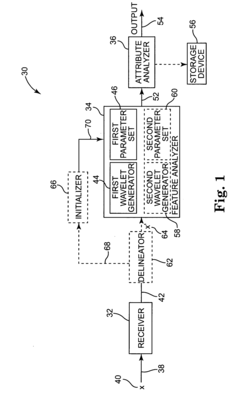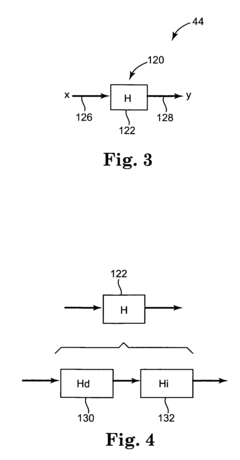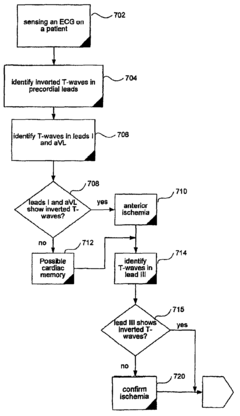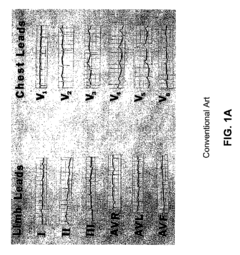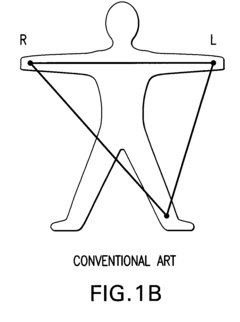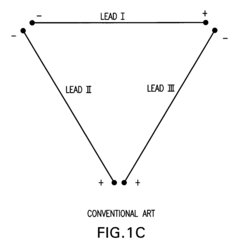Patterns of T wave inversion in digital ECG analysis
AUG 19, 20259 MIN READ
Generate Your Research Report Instantly with AI Agent
Patsnap Eureka helps you evaluate technical feasibility & market potential.
ECG T Wave Inversion Background and Objectives
The analysis of T wave inversion patterns in digital ECG has become increasingly important in modern cardiology. T wave inversion, characterized by a negative deflection of the T wave in the electrocardiogram, can be indicative of various cardiac conditions, ranging from benign variations to life-threatening disorders. The evolution of digital ECG technology has significantly enhanced our ability to detect and interpret these patterns with greater precision and reliability.
Historically, the interpretation of T wave inversions relied heavily on manual analysis by experienced clinicians. However, the advent of digital ECG systems and advanced signal processing techniques has revolutionized this field. These technological advancements have enabled more accurate and consistent identification of T wave inversion patterns, leading to improved diagnostic capabilities and patient outcomes.
The primary objective of studying T wave inversion patterns in digital ECG analysis is to enhance the early detection and risk stratification of cardiac abnormalities. By leveraging digital technologies, researchers and clinicians aim to develop more sophisticated algorithms and diagnostic tools that can identify subtle changes in T wave morphology, which may be indicative of underlying cardiac pathologies.
One of the key goals is to differentiate between physiological and pathological T wave inversions. Physiological inversions can occur in healthy individuals, particularly in certain ECG leads, while pathological inversions may signal conditions such as myocardial ischemia, cardiomyopathies, or electrolyte imbalances. The ability to accurately distinguish between these types of inversions is crucial for appropriate clinical decision-making and patient management.
Another important objective is to establish standardized criteria for T wave inversion analysis in digital ECGs. This standardization would facilitate more consistent interpretation across different healthcare settings and enable more reliable comparisons in clinical research. It would also support the development of automated diagnostic systems that can assist clinicians in ECG interpretation, potentially reducing human error and improving diagnostic accuracy.
Furthermore, researchers are exploring the potential of machine learning and artificial intelligence in analyzing T wave inversion patterns. These advanced computational techniques hold promise for identifying complex patterns and relationships that may not be apparent to the human eye, potentially uncovering new diagnostic markers or risk factors associated with T wave inversions.
As digital ECG technology continues to evolve, there is also a focus on integrating T wave inversion analysis with other cardiac parameters and clinical data. This holistic approach aims to provide a more comprehensive assessment of cardiac health, enabling personalized risk stratification and treatment strategies for patients with suspected or confirmed cardiac conditions.
Historically, the interpretation of T wave inversions relied heavily on manual analysis by experienced clinicians. However, the advent of digital ECG systems and advanced signal processing techniques has revolutionized this field. These technological advancements have enabled more accurate and consistent identification of T wave inversion patterns, leading to improved diagnostic capabilities and patient outcomes.
The primary objective of studying T wave inversion patterns in digital ECG analysis is to enhance the early detection and risk stratification of cardiac abnormalities. By leveraging digital technologies, researchers and clinicians aim to develop more sophisticated algorithms and diagnostic tools that can identify subtle changes in T wave morphology, which may be indicative of underlying cardiac pathologies.
One of the key goals is to differentiate between physiological and pathological T wave inversions. Physiological inversions can occur in healthy individuals, particularly in certain ECG leads, while pathological inversions may signal conditions such as myocardial ischemia, cardiomyopathies, or electrolyte imbalances. The ability to accurately distinguish between these types of inversions is crucial for appropriate clinical decision-making and patient management.
Another important objective is to establish standardized criteria for T wave inversion analysis in digital ECGs. This standardization would facilitate more consistent interpretation across different healthcare settings and enable more reliable comparisons in clinical research. It would also support the development of automated diagnostic systems that can assist clinicians in ECG interpretation, potentially reducing human error and improving diagnostic accuracy.
Furthermore, researchers are exploring the potential of machine learning and artificial intelligence in analyzing T wave inversion patterns. These advanced computational techniques hold promise for identifying complex patterns and relationships that may not be apparent to the human eye, potentially uncovering new diagnostic markers or risk factors associated with T wave inversions.
As digital ECG technology continues to evolve, there is also a focus on integrating T wave inversion analysis with other cardiac parameters and clinical data. This holistic approach aims to provide a more comprehensive assessment of cardiac health, enabling personalized risk stratification and treatment strategies for patients with suspected or confirmed cardiac conditions.
Clinical Significance of T Wave Inversion Patterns
T wave inversion patterns in digital ECG analysis hold significant clinical importance in the diagnosis and prognosis of various cardiac conditions. These patterns are characterized by the reversal of the normal T wave morphology, where the wave becomes negative instead of its typical positive deflection. The clinical significance of T wave inversion lies in its ability to indicate underlying cardiac pathologies, ranging from benign conditions to life-threatening disorders.
In the context of myocardial ischemia, T wave inversion serves as a crucial marker. It often precedes ST-segment changes and can be an early indicator of coronary artery disease or acute coronary syndrome. The presence of new or dynamic T wave inversions, particularly in the precordial leads, warrants immediate attention and further investigation to rule out acute cardiac events.
T wave inversion patterns also play a vital role in identifying structural heart diseases. In hypertrophic cardiomyopathy, for instance, deep T wave inversions in the lateral precordial leads (V4-V6) are a hallmark finding. These inversions reflect the underlying myocardial hypertrophy and fibrosis characteristic of the disease. Similarly, in arrhythmogenic right ventricular cardiomyopathy, T wave inversions in the right precordial leads (V1-V3) are a major diagnostic criterion.
The distribution and extent of T wave inversions provide valuable insights into the severity and location of cardiac abnormalities. Global T wave inversions, affecting multiple leads, may indicate more diffuse cardiac pathology, such as myocarditis or pericarditis. Conversely, localized inversions can point to regional myocardial involvement, as seen in certain types of cardiomyopathies or following myocardial infarction.
In the realm of electrolyte disturbances, T wave inversions can be indicative of metabolic derangements. Hypokalemia, for instance, may manifest as T wave flattening or inversion, often accompanied by prominent U waves. Recognition of these patterns is crucial for prompt correction of electrolyte imbalances and prevention of potentially life-threatening arrhythmias.
It is important to note that T wave inversions can also be a normal variant in certain populations. For example, persistent juvenile T wave pattern, characterized by T wave inversions in the right precordial leads, is a benign finding in young individuals, particularly athletes. Distinguishing these normal variants from pathological inversions is essential to avoid unnecessary interventions and patient anxiety.
The advent of digital ECG analysis has revolutionized the interpretation of T wave inversion patterns. Automated algorithms can now detect subtle changes in T wave morphology, quantify the degree of inversion, and track dynamic changes over time. This technological advancement enhances the sensitivity and specificity of T wave inversion detection, potentially leading to earlier diagnosis and more accurate risk stratification in cardiac patients.
In the context of myocardial ischemia, T wave inversion serves as a crucial marker. It often precedes ST-segment changes and can be an early indicator of coronary artery disease or acute coronary syndrome. The presence of new or dynamic T wave inversions, particularly in the precordial leads, warrants immediate attention and further investigation to rule out acute cardiac events.
T wave inversion patterns also play a vital role in identifying structural heart diseases. In hypertrophic cardiomyopathy, for instance, deep T wave inversions in the lateral precordial leads (V4-V6) are a hallmark finding. These inversions reflect the underlying myocardial hypertrophy and fibrosis characteristic of the disease. Similarly, in arrhythmogenic right ventricular cardiomyopathy, T wave inversions in the right precordial leads (V1-V3) are a major diagnostic criterion.
The distribution and extent of T wave inversions provide valuable insights into the severity and location of cardiac abnormalities. Global T wave inversions, affecting multiple leads, may indicate more diffuse cardiac pathology, such as myocarditis or pericarditis. Conversely, localized inversions can point to regional myocardial involvement, as seen in certain types of cardiomyopathies or following myocardial infarction.
In the realm of electrolyte disturbances, T wave inversions can be indicative of metabolic derangements. Hypokalemia, for instance, may manifest as T wave flattening or inversion, often accompanied by prominent U waves. Recognition of these patterns is crucial for prompt correction of electrolyte imbalances and prevention of potentially life-threatening arrhythmias.
It is important to note that T wave inversions can also be a normal variant in certain populations. For example, persistent juvenile T wave pattern, characterized by T wave inversions in the right precordial leads, is a benign finding in young individuals, particularly athletes. Distinguishing these normal variants from pathological inversions is essential to avoid unnecessary interventions and patient anxiety.
The advent of digital ECG analysis has revolutionized the interpretation of T wave inversion patterns. Automated algorithms can now detect subtle changes in T wave morphology, quantify the degree of inversion, and track dynamic changes over time. This technological advancement enhances the sensitivity and specificity of T wave inversion detection, potentially leading to earlier diagnosis and more accurate risk stratification in cardiac patients.
Current Challenges in Digital ECG T Wave Analysis
Digital ECG analysis faces several significant challenges in accurately interpreting T wave inversions. One of the primary difficulties lies in distinguishing pathological T wave inversions from normal variants. The T wave morphology can be influenced by various factors, including heart rate, electrolyte imbalances, and medication effects, making it challenging to establish definitive criteria for abnormal inversions.
Another major challenge is the variability in T wave patterns across different ECG leads. T wave inversions may appear in some leads but not others, requiring sophisticated algorithms to analyze the spatial distribution and consistency of these inversions across the 12-lead ECG. This complexity is further compounded by the need to consider the patient's clinical context, as T wave inversions can have different implications depending on the individual's age, gender, and medical history.
The presence of noise and artifacts in digital ECG recordings poses a significant obstacle to accurate T wave analysis. These disturbances can mask subtle changes in T wave morphology or create false inversions, leading to potential misinterpretation. Developing robust signal processing techniques to filter out noise while preserving the integrity of the T wave signal remains an ongoing challenge in the field.
Furthermore, the dynamic nature of T wave inversions presents difficulties in longitudinal analysis. T wave patterns may change over time, either due to the progression of underlying pathology or as a result of therapeutic interventions. Current digital ECG analysis systems struggle to effectively track and interpret these temporal changes, limiting their ability to provide comprehensive insights into a patient's cardiac health over time.
Interoperability and standardization issues also hinder progress in digital ECG T wave analysis. Different ECG recording devices and analysis software may use varying algorithms and criteria for identifying T wave inversions, leading to inconsistencies in interpretation across different healthcare settings. Establishing universally accepted standards for T wave inversion detection and classification is crucial for improving the reliability and comparability of digital ECG analyses.
Lastly, the integration of machine learning and artificial intelligence into T wave analysis, while promising, introduces new challenges. These include the need for large, diverse, and well-annotated datasets for training algorithms, as well as concerns about the interpretability and explainability of AI-derived conclusions regarding T wave inversions. Balancing the potential benefits of advanced analytics with the need for clinical validation and transparency remains a significant hurdle in the field of digital ECG analysis.
Another major challenge is the variability in T wave patterns across different ECG leads. T wave inversions may appear in some leads but not others, requiring sophisticated algorithms to analyze the spatial distribution and consistency of these inversions across the 12-lead ECG. This complexity is further compounded by the need to consider the patient's clinical context, as T wave inversions can have different implications depending on the individual's age, gender, and medical history.
The presence of noise and artifacts in digital ECG recordings poses a significant obstacle to accurate T wave analysis. These disturbances can mask subtle changes in T wave morphology or create false inversions, leading to potential misinterpretation. Developing robust signal processing techniques to filter out noise while preserving the integrity of the T wave signal remains an ongoing challenge in the field.
Furthermore, the dynamic nature of T wave inversions presents difficulties in longitudinal analysis. T wave patterns may change over time, either due to the progression of underlying pathology or as a result of therapeutic interventions. Current digital ECG analysis systems struggle to effectively track and interpret these temporal changes, limiting their ability to provide comprehensive insights into a patient's cardiac health over time.
Interoperability and standardization issues also hinder progress in digital ECG T wave analysis. Different ECG recording devices and analysis software may use varying algorithms and criteria for identifying T wave inversions, leading to inconsistencies in interpretation across different healthcare settings. Establishing universally accepted standards for T wave inversion detection and classification is crucial for improving the reliability and comparability of digital ECG analyses.
Lastly, the integration of machine learning and artificial intelligence into T wave analysis, while promising, introduces new challenges. These include the need for large, diverse, and well-annotated datasets for training algorithms, as well as concerns about the interpretability and explainability of AI-derived conclusions regarding T wave inversions. Balancing the potential benefits of advanced analytics with the need for clinical validation and transparency remains a significant hurdle in the field of digital ECG analysis.
Existing Algorithms for T Wave Inversion Detection
01 ECG analysis for T wave inversion detection
Methods and systems for analyzing electrocardiogram (ECG) signals to detect and characterize T wave inversions. This involves processing ECG data to identify abnormal T wave morphologies, which can be indicative of various cardiac conditions. Advanced algorithms are used to differentiate between normal and pathological T wave inversions.- Detection and analysis of T wave inversion patterns: Methods and systems for detecting and analyzing T wave inversion patterns in electrocardiogram (ECG) signals. These techniques involve signal processing algorithms to identify characteristic features of inverted T waves, which can be indicative of various cardiac conditions.
- Machine learning approaches for T wave inversion classification: Application of machine learning and artificial intelligence techniques to classify and interpret T wave inversion patterns. These methods can improve the accuracy of diagnosis and help in identifying subtle patterns that may be difficult for human interpreters to detect.
- Wearable devices for continuous T wave monitoring: Development of wearable ECG devices capable of continuous monitoring and real-time analysis of T wave patterns. These devices can provide early warning of potential cardiac issues and allow for long-term tracking of T wave changes.
- T wave inversion in specific cardiac conditions: Studies and methods focusing on T wave inversion patterns associated with specific cardiac conditions such as myocardial ischemia, hypertrophic cardiomyopathy, and other structural heart diseases. This includes techniques for differentiating between pathological and physiological T wave inversions.
- Integration of T wave analysis with other cardiac parameters: Systems and methods that combine T wave inversion analysis with other cardiac parameters such as QT interval, ST segment changes, and heart rate variability. This integrated approach aims to provide a more comprehensive assessment of cardiac health and improve diagnostic accuracy.
02 Machine learning approaches for T wave pattern recognition
Application of machine learning and artificial intelligence techniques to improve the accuracy of T wave inversion pattern recognition. These methods involve training models on large datasets of ECG recordings to automatically identify and classify different types of T wave inversions, potentially enabling earlier detection of cardiac abnormalities.Expand Specific Solutions03 Wearable devices for continuous T wave monitoring
Development of wearable ECG devices capable of continuous monitoring and real-time analysis of T wave patterns. These devices aim to provide early warning of potential cardiac issues by detecting subtle changes in T wave morphology over time, allowing for more timely medical intervention.Expand Specific Solutions04 Integration of T wave analysis in cardiac imaging
Methods for combining T wave inversion data from ECG with advanced cardiac imaging techniques such as MRI or CT scans. This integrated approach aims to provide a more comprehensive assessment of cardiac health by correlating electrical abnormalities with structural or functional changes in the heart.Expand Specific Solutions05 Personalized risk assessment using T wave patterns
Development of algorithms and systems for personalized cardiac risk assessment based on individual T wave inversion patterns. These methods take into account factors such as age, gender, medical history, and lifestyle to provide more accurate predictions of cardiac events and guide preventive interventions.Expand Specific Solutions
Key Players in Digital ECG Analysis Industry
The field of T wave inversion analysis in digital ECG is in a mature stage of development, with established market players and ongoing research. The global ECG market size is substantial, estimated to reach $10.3 billion by 2024. Technologically, the field is well-developed, with companies like Medtronic, Pacesetter, and Sorin CRM offering advanced ECG analysis solutions. However, there's continuous innovation, particularly in AI-driven analysis, as evidenced by emerging players like TriVirum and Anhui HeartVoice Medical Technology. Academic institutions such as Johns Hopkins University and Shanghai Jiao Tong University contribute significantly to research, while companies like Philips and GE maintain strong market positions with their comprehensive healthcare technology portfolios.
Medtronic, Inc.
Technical Solution: Medtronic has developed advanced algorithms for digital ECG analysis, focusing on T wave inversion patterns. Their approach utilizes machine learning techniques to analyze large datasets of ECG recordings, enabling the identification of subtle T wave changes indicative of various cardiac conditions[1]. The company's technology employs a multi-lead ECG analysis system that combines temporal and spatial information to enhance the accuracy of T wave inversion detection[3]. Medtronic's solution also incorporates real-time monitoring capabilities, allowing for continuous assessment of T wave morphology changes in both clinical and remote patient monitoring settings[5].
Strengths: Comprehensive multi-lead analysis, real-time monitoring capabilities, and extensive clinical data integration. Weaknesses: Potential for high computational requirements and dependency on large, diverse datasets for algorithm training.
Koninklijke Philips NV
Technical Solution: Philips has developed an innovative digital ECG analysis system that focuses on the detection and interpretation of T wave inversion patterns. Their approach utilizes a combination of traditional signal processing techniques and advanced machine learning algorithms to analyze ECG waveforms[2]. Philips' system employs a novel method for ECG signal segmentation that enhances the accuracy of T wave identification and characterization[4]. The technology also incorporates a multi-scale analysis technique that allows for the detection of both subtle and pronounced T wave inversions across different frequency bands[6]. Additionally, Philips has implemented a unique feature that correlates T wave inversion patterns with other ECG parameters and clinical data, providing a more comprehensive cardiac risk assessment[8]. The system also includes a user-friendly interface that presents T wave inversion findings in an easily interpretable format for clinicians[10].
Strengths: Advanced signal processing, multi-scale analysis, and integration with clinical data for comprehensive risk assessment. Weaknesses: May require specialized training for optimal use and interpretation of results.
Innovative Approaches in T Wave Morphology Analysis
Method of processing electrocardiogram waveform
PatentInactiveUS20080015452A1
Innovation
- A method employing wavelet matching techniques, specifically using Kovtun-Ricci wavelets, to analyze ECG waveforms by generating prototype wavelets that match T-wave features, allowing for precise measurement of T-wave alternans and related parameters, and reducing data storage and transmission requirements through wavelet parameter objects.
Differentiating ischemic from non-ischemic T-wave inversion
PatentInactiveUS7925336B2
Innovation
- A method and system that calculate the direction of the T-wave vector from electrocardiographic data to diagnose ischemia (vector between 75° and 200°) and cardiac memory (vector between 0° and -90°) to distinguish between the two conditions.
Regulatory Framework for Digital ECG Diagnostic Tools
The regulatory framework for digital ECG diagnostic tools is a critical aspect of ensuring the safety, efficacy, and reliability of these advanced medical technologies. In the United States, the Food and Drug Administration (FDA) plays a pivotal role in overseeing the development, approval, and implementation of digital ECG analysis tools, including those focused on T wave inversion patterns.
The FDA classifies digital ECG diagnostic tools as medical devices, typically falling under Class II, which requires a 510(k) premarket notification. This classification acknowledges the potential risks associated with these devices while recognizing their established technological characteristics. Manufacturers must demonstrate that their digital ECG analysis tools are substantially equivalent to a legally marketed predicate device in terms of safety and effectiveness.
For digital ECG tools specifically designed to analyze T wave inversion patterns, the regulatory requirements may be more stringent due to the critical nature of this ECG feature in diagnosing various cardiac conditions. The FDA may require clinical data to support the accuracy and reliability of the algorithm in detecting and interpreting T wave inversions across diverse patient populations.
Software as a Medical Device (SaMD) regulations also apply to digital ECG analysis tools. These regulations focus on the software's intended use, the level of risk to patients, and the importance of the information provided by the software to healthcare decision-making. For T wave inversion analysis, which can be crucial in diagnosing conditions like myocardial ischemia or cardiomyopathy, the software would likely be categorized as higher risk, necessitating more comprehensive validation and verification processes.
International regulatory bodies, such as the European Medicines Agency (EMA) and the UK's Medicines and Healthcare products Regulatory Agency (MHRA), have similar frameworks in place. The EU Medical Device Regulation (MDR) and In Vitro Diagnostic Regulation (IVDR) provide comprehensive guidelines for digital health technologies, including ECG analysis tools. These regulations emphasize the importance of clinical evidence, risk management, and post-market surveillance.
Cybersecurity and data protection regulations also play a significant role in the regulatory landscape for digital ECG diagnostic tools. Given the sensitive nature of ECG data and the increasing connectivity of medical devices, manufacturers must comply with regulations such as HIPAA in the US and GDPR in the EU to ensure patient data privacy and security.
As the field of digital ECG analysis continues to evolve, particularly with advancements in artificial intelligence and machine learning, regulatory frameworks are likely to adapt. Future regulations may focus more on the validation of AI algorithms, the interpretability of machine learning models, and the continuous monitoring of algorithm performance in real-world settings.
The FDA classifies digital ECG diagnostic tools as medical devices, typically falling under Class II, which requires a 510(k) premarket notification. This classification acknowledges the potential risks associated with these devices while recognizing their established technological characteristics. Manufacturers must demonstrate that their digital ECG analysis tools are substantially equivalent to a legally marketed predicate device in terms of safety and effectiveness.
For digital ECG tools specifically designed to analyze T wave inversion patterns, the regulatory requirements may be more stringent due to the critical nature of this ECG feature in diagnosing various cardiac conditions. The FDA may require clinical data to support the accuracy and reliability of the algorithm in detecting and interpreting T wave inversions across diverse patient populations.
Software as a Medical Device (SaMD) regulations also apply to digital ECG analysis tools. These regulations focus on the software's intended use, the level of risk to patients, and the importance of the information provided by the software to healthcare decision-making. For T wave inversion analysis, which can be crucial in diagnosing conditions like myocardial ischemia or cardiomyopathy, the software would likely be categorized as higher risk, necessitating more comprehensive validation and verification processes.
International regulatory bodies, such as the European Medicines Agency (EMA) and the UK's Medicines and Healthcare products Regulatory Agency (MHRA), have similar frameworks in place. The EU Medical Device Regulation (MDR) and In Vitro Diagnostic Regulation (IVDR) provide comprehensive guidelines for digital health technologies, including ECG analysis tools. These regulations emphasize the importance of clinical evidence, risk management, and post-market surveillance.
Cybersecurity and data protection regulations also play a significant role in the regulatory landscape for digital ECG diagnostic tools. Given the sensitive nature of ECG data and the increasing connectivity of medical devices, manufacturers must comply with regulations such as HIPAA in the US and GDPR in the EU to ensure patient data privacy and security.
As the field of digital ECG analysis continues to evolve, particularly with advancements in artificial intelligence and machine learning, regulatory frameworks are likely to adapt. Future regulations may focus more on the validation of AI algorithms, the interpretability of machine learning models, and the continuous monitoring of algorithm performance in real-world settings.
Integration with Electronic Health Records Systems
The integration of T wave inversion pattern analysis in digital ECG with Electronic Health Records (EHR) systems represents a significant advancement in cardiovascular care. This integration allows for seamless incorporation of ECG data into patients' comprehensive medical records, enhancing the overall quality of care and facilitating more informed clinical decision-making.
EHR systems serve as centralized repositories for patient information, including medical history, laboratory results, and diagnostic imaging. By integrating T wave inversion pattern analysis directly into these systems, healthcare providers can access critical ECG data alongside other relevant patient information. This holistic view enables clinicians to make more accurate diagnoses and develop tailored treatment plans.
The integration process typically involves the development of standardized data formats and protocols to ensure interoperability between ECG analysis software and EHR systems. HL7 (Health Level Seven) standards are commonly employed to facilitate this data exchange, allowing for consistent and reliable transmission of ECG findings across different healthcare platforms.
One of the key benefits of this integration is the ability to track changes in T wave inversion patterns over time. EHR systems can store multiple ECG recordings, enabling clinicians to observe trends and identify potential cardiac issues before they become critical. This longitudinal view of a patient's cardiac health can be invaluable in managing chronic conditions and assessing the effectiveness of treatments.
Moreover, the integration of T wave inversion analysis with EHR systems supports the implementation of clinical decision support tools. These tools can automatically flag abnormal T wave patterns, alerting healthcare providers to potential cardiac issues that may require immediate attention. This proactive approach to patient care can lead to earlier interventions and improved outcomes.
The integration also facilitates remote consultation and telemedicine services. Cardiologists can review ECG data and T wave inversion patterns remotely, providing expert opinions without the need for in-person visits. This capability is particularly valuable in rural or underserved areas where access to specialized cardiac care may be limited.
From a research perspective, the integration of T wave inversion analysis with EHR systems creates opportunities for large-scale studies and data mining. Researchers can analyze anonymized ECG data across diverse patient populations, potentially uncovering new insights into cardiac health and disease progression.
However, the implementation of this integration faces several challenges. These include ensuring data security and patient privacy, managing the increased data storage requirements, and training healthcare professionals to effectively utilize the integrated systems. Addressing these challenges is crucial for the successful adoption and widespread use of integrated T wave inversion analysis in clinical practice.
EHR systems serve as centralized repositories for patient information, including medical history, laboratory results, and diagnostic imaging. By integrating T wave inversion pattern analysis directly into these systems, healthcare providers can access critical ECG data alongside other relevant patient information. This holistic view enables clinicians to make more accurate diagnoses and develop tailored treatment plans.
The integration process typically involves the development of standardized data formats and protocols to ensure interoperability between ECG analysis software and EHR systems. HL7 (Health Level Seven) standards are commonly employed to facilitate this data exchange, allowing for consistent and reliable transmission of ECG findings across different healthcare platforms.
One of the key benefits of this integration is the ability to track changes in T wave inversion patterns over time. EHR systems can store multiple ECG recordings, enabling clinicians to observe trends and identify potential cardiac issues before they become critical. This longitudinal view of a patient's cardiac health can be invaluable in managing chronic conditions and assessing the effectiveness of treatments.
Moreover, the integration of T wave inversion analysis with EHR systems supports the implementation of clinical decision support tools. These tools can automatically flag abnormal T wave patterns, alerting healthcare providers to potential cardiac issues that may require immediate attention. This proactive approach to patient care can lead to earlier interventions and improved outcomes.
The integration also facilitates remote consultation and telemedicine services. Cardiologists can review ECG data and T wave inversion patterns remotely, providing expert opinions without the need for in-person visits. This capability is particularly valuable in rural or underserved areas where access to specialized cardiac care may be limited.
From a research perspective, the integration of T wave inversion analysis with EHR systems creates opportunities for large-scale studies and data mining. Researchers can analyze anonymized ECG data across diverse patient populations, potentially uncovering new insights into cardiac health and disease progression.
However, the implementation of this integration faces several challenges. These include ensuring data security and patient privacy, managing the increased data storage requirements, and training healthcare professionals to effectively utilize the integrated systems. Addressing these challenges is crucial for the successful adoption and widespread use of integrated T wave inversion analysis in clinical practice.
Unlock deeper insights with Patsnap Eureka Quick Research — get a full tech report to explore trends and direct your research. Try now!
Generate Your Research Report Instantly with AI Agent
Supercharge your innovation with Patsnap Eureka AI Agent Platform!

